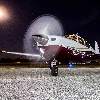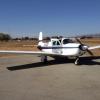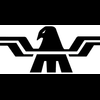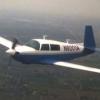Leaderboard
Popular Content
Showing content with the highest reputation on 12/05/2017 in all areas
-
IT'S OFFICIAL. As of today I am now the proud owner of this beautiful 1967 M20 F. N9268M. It's a life long dream come true. Thanks to the previous owner Alan Basinger for his efforts in closing the sale. Also thanks to Lisa Bainter at Aero -Space Reports and AOPA and Falcon Insurance for your assistance throughout. A special thanks goes to Don Maxwell for his expertise and advice and continued great service. I'm based in Santa Monica, Ca. I Hope to meet other Mooniacs in the very near future.13 points
-
Jose', I agree with you. Having started out with round motors, high power settings were considered stressful on the engine and high power settings were time-limited. However, it seems to be in vogue on Mooneyspace to climb at high power settings and the POH recommended reduction to 26"/2600 is poo-poo'd by most of the experts who post here. The thought is that such a reduction is an OWT and that the engine is certified at max power to TBO. It just seems intuitive to me that reducing power will produce less stress on the engine. Less stress=longevity/reliability. I guess I'm a dinosaur.5 points
-
A recent personal experience with ice. Not good. First a little background – I live in SD and have been flying the northern tear year round for some 30 years. I'd like to think I know ice but she's a fickle thing with many faces.I currently fly a Mooney with TKS and am very familiar with the systems capabilities and lack there of. It was April 7, 2017. The flight was from Stockton, CA (KSCK) to Corvallis, OR (KCVO). IFR conditions prevailed over the mountains with NO icing forecasted. Along the southern Oregon coast at approximately 12,000 feet, temperature hovering around 0 to -2 C (10 C lower than forecasted), TKS system primed and running on low, I encountered freezing rain! I immediately turned the TKS system to high. In a matter of 10 seconds my windshield and leading edge of the wing accumulated approximately 1 1/2 inch of ice-maybe more. it looked as though my tail was worse. I could not believe how incredibly fast things happened. From my perspective at this moment the TKS system was of no value. The system was completely overwhelmed. TKS fluid could be seen running back over the top of the wing from previous use. The ice accumulated perhaps a foot back from the leading edge. Within five seconds of the encounter I had requested immediate course reversal from ATC. Per my routine I make mental notes of cloud brakes/layers/temps and other more favorable locations as I continually update plan B, C and D. I returned to a clearing that was shortly behind me. I made a circling descending pattern to the MEA. This put me in warmer air, out of the rain and allowed the TKS system to catch up. I was able to shed ice off all protected surfaces of the plane.I completed the rest of the trip uneventfully at a lower altitude. On my same ATC frequency was another pilot in my same area. He was in serious trouble. I could hear the frantic cries of the pilot asking for help. "I have no airspeed", "I can't maintain altitude", "I'm losing control", "I'm going down" were repeated over and over. ATC was trying to offer assistance but could do little. After about 5 minutes the radio went silent. I later learned the next AM that a Malibu went down killing all 4 on board. I don't know if it was the aircraft- I suspect it was given the time and location. A very sobering experience. Take home lessons: 1. Ice kills, period! (even in capable aircraft) 2. Wether forecasted or not, expect ice in ANY visible moisture with temps +4C or lower (maybe to -25 or -30 C). This includes summer months as well. I have encountered ice every month of the year. 3. With temp inversions, beware if you are flying in freezing temps below clouds-VFR. 4. Always have plan B and C. Updates these plans continuously. 5. Expect the unexpected. 6. If you are FIKI equipped, you are not invincible. These systems should be considered a means of buying time to get out of the icing condition. 7. There is a reason non-FIKI ideas (WD-40, Rain-X, pre flight TKS spray etc.) are not certified. We and are passengers (family) are not test subjects. I know will all want more utility out of our planes. Flying safe will allow you more time to get that utility. 8. Icing conditions are VERY unpredictable. You can think "I will only pick up a little" and actually load up faster than you can believe. In a real way, ice is winters equivalent of the summer thunderstorm. I'm not sure which is worse. You will quickly run out of power if airframe icing is not Shed. 9. If you are picking up ice on descent.....Don't use airbrakes and consider a no flap landing with higher than normal airspeed-perhaps +10 kts, maybe more if heavy. 10. When/if you encounter ice, take immediate pro active action to get out of the situation-TIME IS OF THE ESSENCE! The bottom line....treat ice like you want your daughter (or son) treated while dating....With absolute RESPECT!5 points
-
So, it turns out my radio is just fine. @N201MKTurbo is a genius, or I'm a moron. Not sure which, but I'll go with the former for now. First, let's note that I said 'it's been getting worse.' Next, let's note that I've posted several times lately that I'm using my plane training for my Instrument rating. Finally, let's note that I stated that on the audio panel, the audio for the nav comes through on the same 'channel' as the voice. I went down and saw Rich last night. He sat down in the plane and had me fire up the radios. Sure as can be, very staticy. He says "Let's try turning down the nav volume on the radio." Static instantly gone. So... What had happened was - as I was training for my IR, my instructor has been drilling very hard to listen for the morse. So, of course, I had to turn up the volume on the nav side. Now, since the audio from the nav comes through the comm, and it's open squelch... Static. Thanks Rich!4 points
-
Highly Suspect IMO. Tear down an inspection in my shop don’t cost anything. couple hrs is all it takes What also bothers me, Selling the new Prop at list +, then Charging him to take his old parts off of his hands. The way I was brought up in this biz, sell the new Prop discounted, then pay $200-$750 per serialized part. In that Prop there are 5 Serial numbered parts. Blades, Blade Bearings, Hub. That is where the Propeller Shop Makes Money. If the blades are really under minimum, then you have a hub that is potentially worth up to $750 if it’s in good shape(No Repair Sleeves, No over sized studs, minimal blade socket wear). Now the bearings an Actuating Components. Those together are going to be worth another $500-$750 if the Propeller is oil-filled an the parts are in good shape. So you make the sale, get the customer back in the air without having a bad experience. Then you work these same parts through the serviceable Market. Are you going to make tons of money this way? Hell no, Not all on one transaction but you can pay the bills an keep moving on. Being in the Propeller Biz, you have all types of options moving said parts, the typical customer doesn’t. So that why they should cut a break on the front end. Not doing so is Double Dipping the way I see it.4 points
-
4 points
-
Wow!!! Super High new Prop Quote! Not supposed to make Christmas Bonus off of one transaction. I can get that Propeller for much cheaper. I also believe you should get a second opinion on your McCauley blades4 points
-
The heading has always been off about 10 degrees, but the flight plan imports from the G3X so it will give me the right flight plan headings to continue in the event of main PFD / MFD failure. I have to be honest though, never looked at the instrument much to notice the attitude seeming to indicate climb? Will look into that so thanks for the sharp eye! I really need to fly with my local instructor on that instrument only so I'm comfortable with it. Out of 178 hours, I might have 1.5 hours of IMC and no night flight. With the safety record of this bird, I'm avoiding as much IMC as I can until I'm completely up to speed. I REALLY wish the G5 would have been available when I built my panel. It was introduced about a year after the panel was completed. Tom3 points
-
3 points
-
Just case you’re interested in knowing what those medieval things are; It’s a pocket! Sent from my iPhone using Tapatalk Pro3 points
-
Update on Matt's F model cowling. Much closer to being completed. I made my own version of the oil cooler relocation mounting doublets in order to get at least a half an inch of clearance between the engine mount and the cooler. The STC doubler would not give any clearance with the cooler Matt has. David3 points
-
Your service manual has a procedure for weighing the plane. You'll need an IA to sign it off, too. The procedure involves leveling the plane, and maybe with empty tanks, full oil, etc. Sent from my LG-US996 using Tapatalk2 points
-
Well, it's not as good as the touch and go discussion, but it's better than "Family Pressures"!2 points
-
His personal Turbo 310 has engines that have almost 4000 hours and they soldier on, an occasional cylinder due to exhaust valve guide wear and burned valves, which is common. I am not a huge proponent of leaning to CHT. You can lean some engines right into the middle of the red box in winter and they wont show above 360 CHT. My buddy's 260HP Bonanza with the Liquidair baffles wont go above 290 CHT regardless, unless its right when pistons start getting holes in them. Its airplane specific. Better, set the mixture to 15 LOP, and if CHT creeps above your threshold, lean a little more. EGT primary..... CHT, secondary.2 points
-
No, but the opinion that not following this recommendation leads to premature engine failure IS based on feelings... because it's certainly not data. I used to fly a 1964 M20C as well. In the 52 years since that manual was published, real data driven knowledge of our engines, has increased significantly. This is due not only to the last 52 years, but increases in measuring and testing technology, data logging engine monitors, and a very large sample size.2 points
-
Climb at full power and then level off at pattern altitude, wherever that occurs. Then throttle back to 16” to maintain 90 knots on downwind. There is no evidence that climbing at full throttle and 2700 RPM causes any more wear than normal cruise operations. We have ran our airplane for long periods of time (hours even) at full throttle and 2700 RPM, and extended periods of cruise at 83% power as well at sea level density altitude and the oil analysis is consistent with periods where we don’t. What does ruin engines is sitting. And Jose, those connecting rods are about twice as strong as needed. I am convinced by evidence, and I’ve also never seen a broken connecting rod or crank from firewalling the throttle. In fact, the most abused engines I have ever flown were on a travel air. Fuel cutoff and feathered from full power at 1500’, cowl flaps still open, shut down for 2 minutes then restarted and immediately back to full power. Sometimes shut down, feathered, and unfeathered, full power, then another cycle all in half a minute. Sometimes the student tried to feather the engine still running at full power. Anyways, I remarked these engines must break often and he remarked this particular set had 8,000 hours since last overhaul. So let’s worry about actual causes of engine failure and damage rather than non-evidence opinions backed only by feelings.2 points
-
About 5 years ago, I got tired of patches failing over an over again. Decided to take my plane to Paul Beck at Weep No More. 5 years now, leak free. These photos show the before and after. The before photos look like people were trying to work on the tank blind!!! But you can see how Paul gets every last little bit of old sealant off and then does a superb job with the new seals. I recommend him highly. There is not a finer person on the mechanical side of our airplanes than Paul Beck.2 points
-
I wonder if its too late to saw the tail off, flip it around and slap on some bondo?2 points
-
Tom I can’t get over 34 GPH of Jet at with a TAS of 305. That efficiency astounds me. A TBM 850 (granted you’re probably half the weight) - needs 65 GPH for a TAS of 320 at a max FL-310.2 points
-
Me, too. Now there is absolutely, positively no need for me to experience it myself! I like your description of icing cinditions as the winter equivalent of thunderstorms. Easy to remember, easy for everyone to understand.2 points
-
Send the blades and hub in a box to Cody, and let him evaluate. Dont fall for round 2 of the prop shop scam.2 points
-
Had a couple interesting moments in 10 hours of flying this weekend with controllers. I got my clearance to Spruce Creek (south of Daytona Beach) on the ramp at KOSU (Ohio State University Airport, just outside Columbus OH). I had filed FL270 and was given 3,000', expect 270 in 10 minutes. After I thought about it a minute, I called the ground controller back at OSU and asked "how long before I will get higher, I will be to 3,000' in about a minute?" He responds that will be up to Columbus Approach, but I believe I planted the seed. The Lancair is on steroids in colder weather, and to get the gear in the wells before passing 120 knots, the climb angle looks like a rocket (initially about 4,000' a minute). I got handed over the departure before crossing the end of the runway. Coming out of Spruce yesterday, they will never give you your clearance (or allow you into their Class C airspace) until you have flown out from under the ring (under 1200' no less). Anyway, I finally call them when I'm climbing just west of their precious Class C and get my filed ROYES CRG KOSU route as filed, but radar vectors to Royes. I'm climbing pretty fast, which helps get them moving handing me off to the next controller. I got the north DAB approach controller for just a minute or two and then was handed off to JAX center. Reporting up JAX Center says "cleared to destination, via Ann Arbor.... KOSU" (Ann Arbor is a long ways north of Columbus OH). I look at my passenger (Joe) and said "what did he say?" He heard the same thing so I call back and ask him to repeat the "intermediate way point to me". He laughs and says, Ann Arbor, then KOSU.......GO BLUE!!! After a few laughs I verify I can go direct to KOSU and report, I'm actually a Michigander, I'm dropping an Ohio State guy off before going home. BTW, this is the morning after the OSU / Wisconsin Big 10 championship game. When he handed me off 10 minutes later I heard "GO BLUE" one more time and a laugh. He must be from up north. Good thing I didn't tell him I'm a MSU fan (Lansing)!! I would have got KOSU via Atlantic City. Nice to see a controller having fun. Tom2 points
-
The first Mooneymite I ever saw was the one I bought. I already owned a C. The insurance company thought that was close enough... no check out required. Good thing since a single seat checkout is kind of tough. The Mite is a plane you wear. About 2.5 minutes was all I needed to feel comfortable. It was a blast. There are lots of stories of Mites being landed gear up and only needing an hour to install a new prop to fly again. I guess things were a little more relaxed in 1950.2 points
-
Hi everyone, Just wanted to follow up with the resolution. Went to the plane today with my mechanic and IA armed with the ideas above. Upon closer inspection, it was pretty clear that the breather hose was probably not well secured onto the o/a separator. The hose was extremely hard and the bulge for the barb was outside the clamp, and it was too short. Kind of seems like it was just butted up against the o/a and somehow finally became dislodged. I picked up the plane the very end of May and have flown about 140 hours before this happened. Hard to say why this time. We hadn't messed with the breather at any point. To answer some of the questions, no icing and there is an ice/whistle hole on the pipe pretty high up inside the cowl. We replaced the hose, cleaned it up and did a test flight, all good. Flew it home to abq without incident. Thanks again for the incredible support and ideas. Vance2 points
-
2 points
-
2 points
-
Nothin' special. Just my inexpensive, reliable car (that needs a bath) and my inexpensive, reliable airplane (that also needs a bath). (BTW, I do realize that there is only one person on this site who could possibly hit 'like' for this car/airplane combination. Everybody else is probably yawning.)2 points
-
2 points
-
2 points
-
2 points
-
2 points
-
2 points
-
I get the "trifecta" but I was waiting on some to hit the Grand Slam. Where are all the boats, planes, cars and bikes. Here is a vid of my son landing a flip IMG_1823.mov2 points
-
I just joined the forum today. I am researching aircraft to possibly purchase after I retire from the USAF in a couple years. I live in the FL panhandle and would like to visit with an owner about actual performance, operating costs, and possibly take a familiarization flight. (I'd be willing to buy the gas.) In college I worked at an FBO and refueled several Mooneys and helped the mechanic do annuals on a couple of them, but I never had a chance to fly in one. Excited to learn all I can about the C/E/F models!1 point
-
I don't think high power operations in climb are frequent or long enough to do much harm but I think continuous high power operations still can't be good for your engine.1 point
-
Smooth is almost always better...flying planes, driving cars, racing motorcycles...now if only l could execute a smooth golf swing. Sent from my iPhone using Tapatalk1 point
-
I'm pretty sure dinosaurs were still roaming the earth back when my POH was printed... I'm of the belief that knowledge has likely advanced since...1 point
-
Since I'm too old to want to fight a stuck starter somewhere out on the road I replaced my Skytec with a new one after 17 years, Ya, it had been on there 17 years. It was 6 years old at the overhaul so it stayed on. They are rated at 2000 hrs , had 1600 on mine . Hartzell has a new program now if you send in your old Skytec they send you a new one at a great discount. By far most of the time one has trouble with the "starter" it really is the battery telling you its done its job and is checking out. Either just a low change or a bad cell. First thing to try if lubing the starer nose doesn't solve the problem is charge the battery and check it with a hydrometer. I'll bet 9 out of 10 starter problems I've worked on have been battery related and not the starter. Cleaning and lubing the starter nose (bendix) should be a yearly routine especially in a dusty area. Starting the engine only uses about 2% of a good battery charge. If you can't start the engine with it it either has low charge or is about at the end of its life. Even if you can charge it (without checking capacity) you may not have enough stored in the battery to do you any good if your alternator takes a dump and you have to rely on the battery on the flight. Starting the engine really has no bearing on how good your battery is. That is also the fallacy of jump starting or proping a plane with a dead battery and then going right out on a flight. You ain't got nothing to fall back on electrically.1 point
-
N994PT is by far the coolest, smoothest, and nicest aircraft I have ever flown in. I can’t wait to see what the paint looks like. I still tell people how the takeoff acceleration, that plants you into your seat, lasts almost two minutes. Sent from my iPhone using Tapatalk1 point
-
I hope I never have to spend money on my prop, but if I did, Cody has it without a doubt. Talk about transparent and helpful, way to go, Cody. Jeev, I hope you are able to save some $$$ here.1 point
-
Thanks. It is always stressful to read about Mooney Down.... I appreciate your attention to accuracy1 point
-
Nice! I broke the 800 hour total time mark with my last journey...I hope kids enjoy reading through my log books some day...A LOT of events are mentioned over the years in the comments.1 point
-
yea, you might have to be a Facebook friend of Chris's to see his post. He did not post it to a group, but rather on his timeline. Anyway, the plane is sitting in a field, just off the airport. The plane shows no damage, just an off field wheels down landing. Please change the title, OP, as this is sooo very media like....next thing we will read here is the engine stalled and he didn't file a flight plan. Great job keeping everyone unharmed, Chris!1 point
-
Well, I did a trip to Florida this weekend and was able to get a feel for the level of improvement from my speed mods. It appears the oil cooler door was not worth the work. It must close off the air good, as I can only close it 70% at altitude, even when -41 degrees C, without taking the oil temp out of the green. Even closed 100% (which takes about 15 minutes for the oil temp to climb) I'm lucky if I gained a knot. The flap closures were another issue though. My average TAS appears to be 3-5 knots faster. I recorded my highest True Air Speeds ever in 180 hours. Taking my highest and lowest, averaging them, it appears I will be able to bump my filed speed to 305 knots. I think I'll wait for a few more flights, but I saw all ends of my normal flight parameters (altitude, outside air temp, etc) flying from the U.P. to central Florida. For a TKS equipped Lancair, I am definitely in the higher end of the performance envelope and am clearly happy with it. And yes, my camera works for both the tailwind flights and the HEAD WIND flights. In another month I'll be a full blown Mooniac again though. The Lancair will be going for paint and the Rocket will get the cobwebs dusted off it, using it for several Florida trips this winter. Tom1 point
-
Between my iPad, two GPS navigators, HSI and Garmin G5 with a 4 hour battery back up, I highly doubt I would ever have use for my compass. It’s only there because the MEL says it has to be.1 point
-
Big Thanks to MCDSiena for letting me check out his C. Enjoyed meeting you and chatting. I’m gonna have a look at that plane in TX and see how many reasons I can find not to buy it. Sent from my iPad using Tapatalk1 point
-
There is an excellent knowledge course in the wings program advanced phase 1 IIRC. https://www.faasafety.gov/gslac/ALC/CourseLanding.aspx?cId=33 -dan1 point
-
Thanks Don. Yes, restored myself (nearly killed me...as you might imagine from the before picture), except for some things that were farmed out (Chroming, etc.). Yes, chrono speedo only.1 point
-
1 point
-
1 point



























.thumb.png.7c67574d7b28f67b0b4a17760919b1ac.png)


.thumb.jpg.55c318b31497f1c59a3912b07d503432.jpg)












